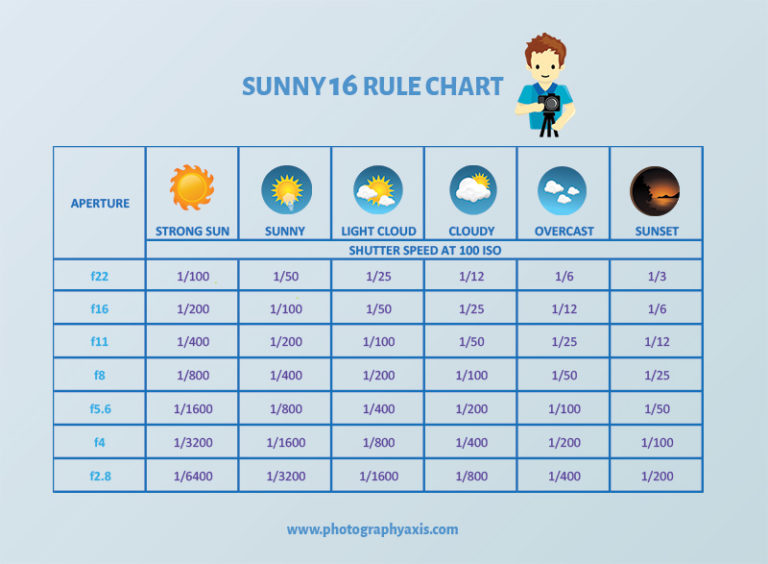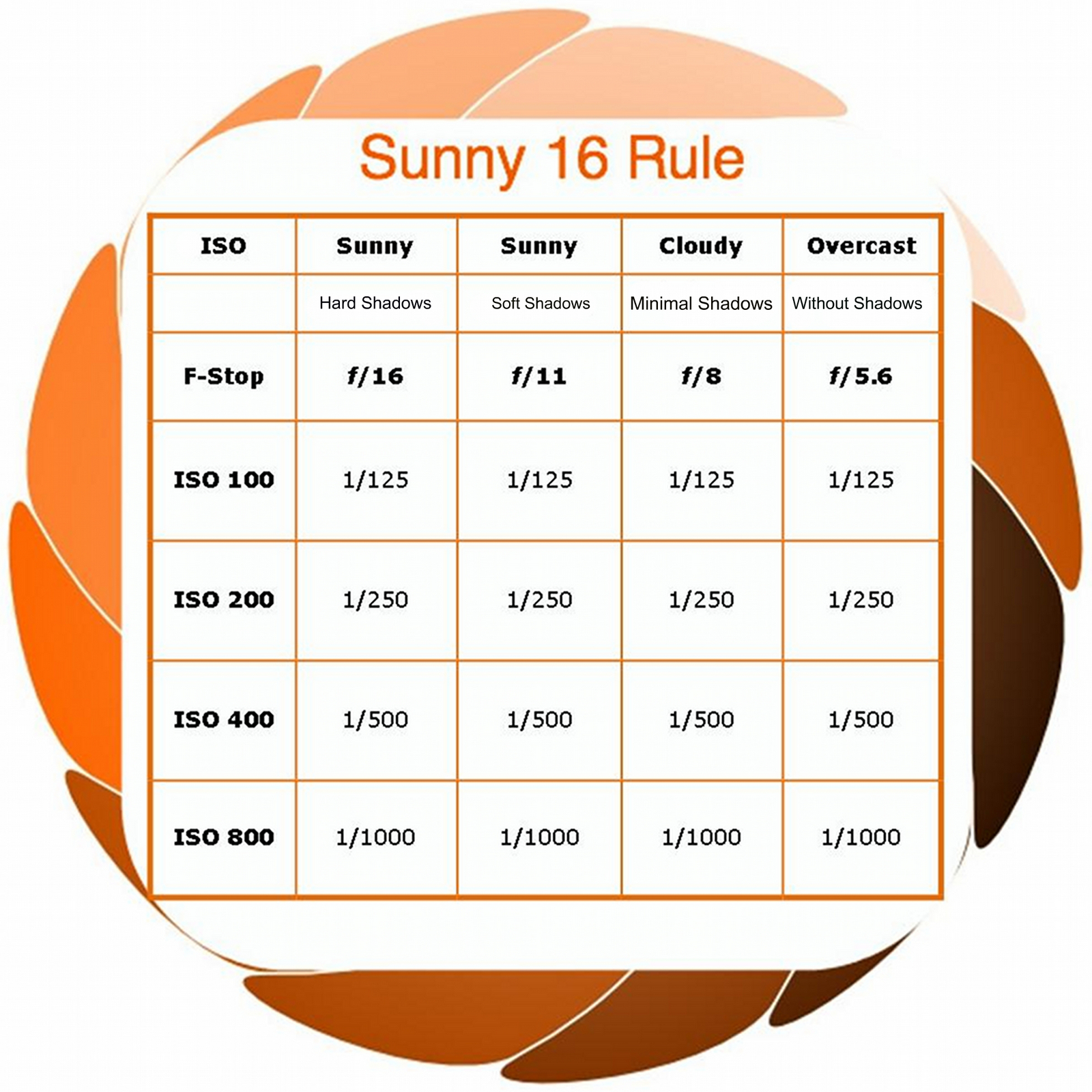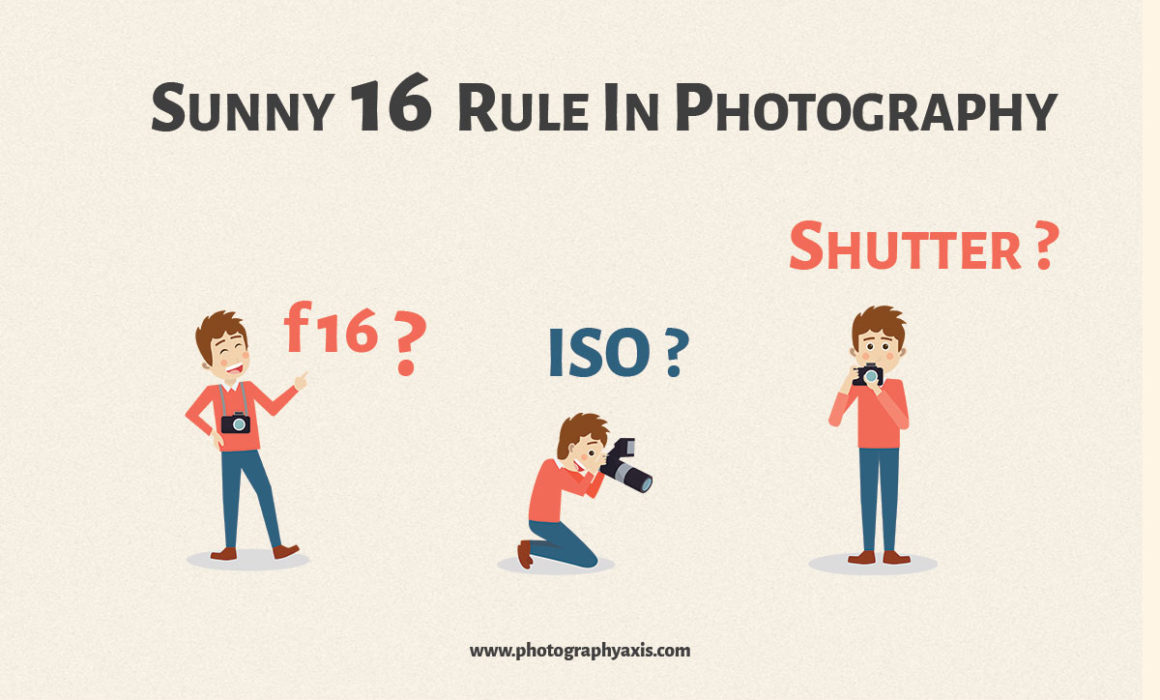Die Sunny 16Regel in der Fotografie Svenger DE
The Sunny 16 Rule is a way to meter for correct exposure during the middle of the day without using the camera's light meter. It's not 100% accurate, so that if you're shooting early or late in the day, or with a low, winter sun, you may need to increase the exposure a little. But it's probably going to be close enough, especially if you.

Sunny 16 Rule in Photography How to Use It? PhotographyAxis
Switch to the sunny 16 rule and set it to sunny f16 at 400 ISO and 1/400 shutter speed and take the same photo. Shoot test varied photos for varied exposures. Distinguish one shot from another using a small piece of paper in your shot to indicate the sunny 16 photos from the metered photos.

Wie fotografiert man ohne Belichtungsmesser? Die Sunny 16 Regel YouTube
Sunlit subject shot on a digital camera set to ISO 100, exposed at f/8 at 1/400 second which is the same exposure value as f/16 for 1/100 second, the recommended "sunny 16" exposure. In photography, the sunny 16 rule (also known as the sunny f /16 rule) is a method of estimating correct daylight exposures without a light meter.Apart from the advantage of independence from a light meter, the.

SUNNY 16 REGEL Belichtungsmessung ohne Belichtungsmesser Analogfotografie lernen YouTube
The Sunny 16 Rule is a guideline for setting camera exposure in bright sunlight without using a light meter. The basic principle: set the lens aperture at ƒ/16 and the shutter speed to the reciprocal of the ISO. For example, with ISO 100, use a shutter speed of 1/125. The rule can be adjusted for various lighting situations by changing the.

What is the Sunny 16 Rule and How to Use it? The Expert Guide
ISO + shutter speed + aperture = exposure. This rule aims to help you fill in the above formula the best. The Sunny 16 Rule states that when you are using an aperture of f/16 on a clear sunny day, you will also be using a shutter speed that is the same as your ISO value. For example, if your ISO is set to 100, you use a shutter speed of 1/100.
Sunny 16 Rule for Great Exposure The Darkroom Photo Lab
The rule states that on a sunny day, you should be able to set the shutter speed to 1/ISO, choose f/16 and get a perfectly exposed negative. For example, you could set the camera to ISO 200, shutter speed 1/200 and aperture at f/16; or ISO 400, 1/400 and f/16 — any lens, any camera. Photographer Tony Corbell recently sparked new interest in.

Back to Basics Understanding the "Sunny 16 Rule" in Photography
How to apply the Sunny 16 Rule. To apply the Sunny 16 Rule one must put their aperture to f/16 to start with, hence the name Sunny 16 rule. Next, you establish your ISO which on a sunny day would be set to ISO 100. Respectively whatever you set your ISO number to you would use the same number for your shutter speed.

Sunny16Regel Analoge Fotografie ohne Belichtungsmesser? YouTube
The Sunny 16 Rule is a way to meter for correct exposure during daylight without using the camera's meter. The basic rule of thumb states that if you have a clear, sunny day and your aperture is at f/16, whatever ISO you are using, your shutter speed will be the reciprocal value of that ISO value (ISO X = 1/X seconds shutter speed) So for.

Nikon Newbie Sunny 16 Cheat Sheet
The sunny 16 rule is a simple way to determine a good exposure for a photograph. On a clear, sunny day, when you are using an aperture of f/16, this rule recommends a shutter speed equal to the reciprocal of your ISO (1/ISO value). At ISO 100, for example, use a shutter speed of 1/100th of a second. At ISO 200, use a shutter speed of 1/200 second.
Die Sunny 16Regel in der Fotografie Svenger DE
Discover unbeatable deals and discounts on the Temu App. Download Now & Save Big! Enjoy up to 90% off only today. Best deals in Australia. Worry-free post-sales guarantee!

Sunny 16 Rule Photography basics, Wedding photography tips, Photography pictures
The Sunny 16 Rule states that when you are using an aperture (or f-stop) of f/16 on a clear sunny day, you are encouraged to use a shutter speed that is the same as your ISO value. For example, if your ISO is set to 100, you use a shutter speed of 1/100. If your ISO is 400, you use a shutter speed of 1/400, and so forth.

Sunny 16 Regel Was ist das denn? (Mit der Leica knipsen wie mit 'ner Holga.) YouTube
In the era of digital cameras and automatic exposure settings, the Sunny 16 rule remains a fundamental and valuable technique for film photographers. Whether you're a seasoned film enthusiast or a beginner exploring the world of analog photography, understanding the Sunny 16 rule can be a game-chang

Sunny 16 Photography's Golden Rule Check out our infographic on making photography easier. Us
The purpose of our Absolute beginner's guide to film photography series is to help demystify the joys of shooting analog. And while we try not to dabble too much in specifics, there is one (sort-of) hard-and-fast analog-era rule we think every film (and digital) shooter should know: the 'Sunny 16' rule.

What is the Sunny 16 Rule in Photography?
There's no hard and fast definitions about what constitutes "slightly overcast" vs "overcast", but you get the idea. 2. Set the Aperture (f/ Stop) Each of those five weather conditions has a corresponding aperture. Set your camera accordingly: Sunny = f/16. Slightly Overcast = f/11.

What is Sunny 16 Chart and How to Use It for Perfect Exposure
It's called the Sunny 16 rule. And when put into practice, you can accurately guess the exposure without using a light meter. All you have to do is know which aperture setting to use in each lighting conditions, then match the ISO of your film stock with the shutter speed on your camera. Once you have those settings, you can reduce the.

Sunny 16 Rule in Photography How to Use It? PhotographyAxis
You've dialed in f/16 as the aperture and are using an ISO of 100. Based on those settings, the Sunny 16 Rule recommends that the shutter speed be 1/100 seconds. Doing so will get you close to a well-exposed image. As another example, if you're shooting at f/16 with an ISO value of 400, your shutter speed would need to be 1/400 seconds.